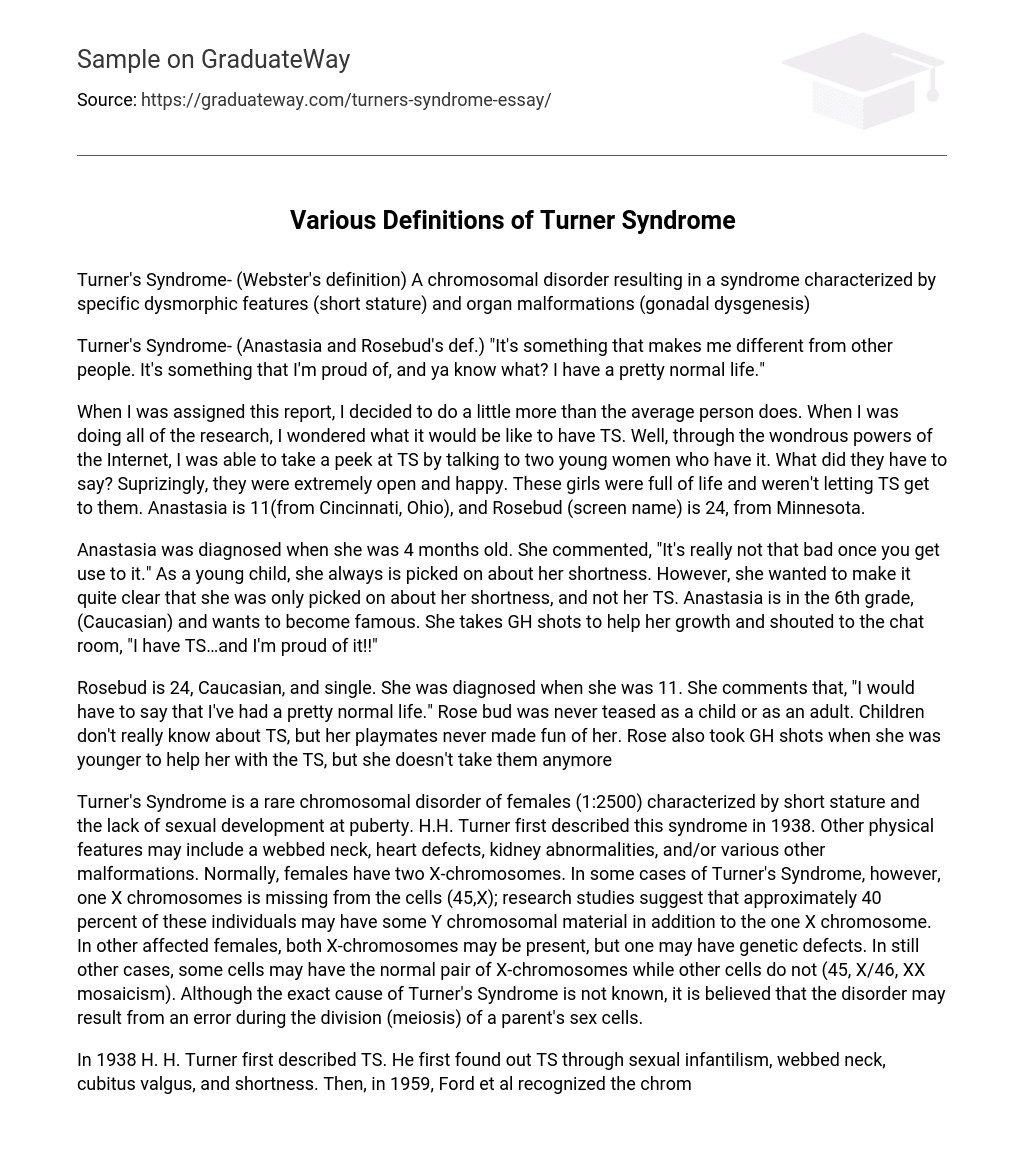Turner’s Syndrome- (Webster’s definition) A chromosomal disorder resulting in a syndrome characterized by specific dysmorphic features (short stature) and organ malformations (gonadal dysgenesis)
Turner’s Syndrome- (Anastasia and Rosebud’s def.) “It’s something that makes me different from other people. It’s something that I’m proud of, and ya know what? I have a pretty normal life.”
When I was assigned this report, I decided to do a little more than the average person does. When I was doing all of the research, I wondered what it would be like to have TS. Well, through the wondrous powers of the Internet, I was able to take a peek at TS by talking to two young women who have it. What did they have to say? Suprizingly, they were extremely open and happy. These girls were full of life and weren’t letting TS get to them. Anastasia is 11(from Cincinnati, Ohio), and Rosebud (screen name) is 24, from Minnesota.
Anastasia was diagnosed when she was 4 months old. She commented, “It’s really not that bad once you get use to it.” As a young child, she always is picked on about her shortness. However, she wanted to make it quite clear that she was only picked on about her shortness, and not her TS. Anastasia is in the 6th grade, (Caucasian) and wants to become famous. She takes GH shots to help her growth and shouted to the chat room, “I have TS…and I’m proud of it!!”
Rosebud is 24, Caucasian, and single. She was diagnosed when she was 11. She comments that, “I would have to say that I’ve had a pretty normal life.” Rose bud was never teased as a child or as an adult. Children don’t really know about TS, but her playmates never made fun of her. Rose also took GH shots when she was younger to help her with the TS, but she doesn’t take them anymore
Turner’s Syndrome is a rare chromosomal disorder of females (1:2500) characterized by short stature and the lack of sexual development at puberty. H.H. Turner first described this syndrome in 1938. Other physical features may include a webbed neck, heart defects, kidney abnormalities, and/or various other malformations. Normally, females have two X-chromosomes. In some cases of Turner’s Syndrome, however, one X chromosomes is missing from the cells (45,X); research studies suggest that approximately 40 percent of these individuals may have some Y chromosomal material in addition to the one X chromosome. In other affected females, both X-chromosomes may be present, but one may have genetic defects. In still other cases, some cells may have the normal pair of X-chromosomes while other cells do not (45, X/46, XX mosaicism). Although the exact cause of Turner’s Syndrome is not known, it is believed that the disorder may result from an error during the division (meiosis) of a parent’s sex cells.
In 1938 H. H. Turner first described TS. He first found out TS through sexual infantilism, webbed neck, cubitus valgus, and shortness. Then, in 1959, Ford et al recognized the chromosomal basis of syndrome. The clinical features are Classic, Newborn, and Childhood/Adolescence. In the Classic, there is short stature, gonadal dysgenesis, and lymphedema. In the Newborns, they are small for dates, lymphedema of hands and feet, and excessive skin at nape of neck. In Childhood/Adolescence, there is a 98% short stature, 95% gonadal dysgenesis, 82% high palate, 80% short neck, low hairline, 78% hypoplastic, widely-spaced nipples, 75% broad chest, cubitus valgus, nail hypoplasia, and a 70% lymphedema, prominent anomalous ears, and excessive nevi.
Ways of management are supportive, surgery, and endocrine. For supportive, you should follow-up with ophthalmology, ENT, dentist, orthopedics, cardiology, urology, genetic counseling. For surgery, there is the removal of bilateral streak gonads prior to starting in 45,XO/46,XY. With endocrine there is growth, gonadal failure, fertility, and hypothyroidism. With the growth, there is a low dose of estrogen at an early age with slow progression to a higher dosage, and a combination of low dose estrogen, growth hormone, and anabolic steroid. With gonadal failure, there is a replacement with estrogen and progesterone. You must begin at the time appropriate for teenage peers, and start with a low dose estrogen for 1-2 years then progress to larger doses cycled with progesterone and then maintain with the birth control pill. With fertility, there is the oocyte donation, gamete or embryo transplant. And finally, with the hypothroidism, there is replacement therapy. TS is a female disease and is more common that one would think.





